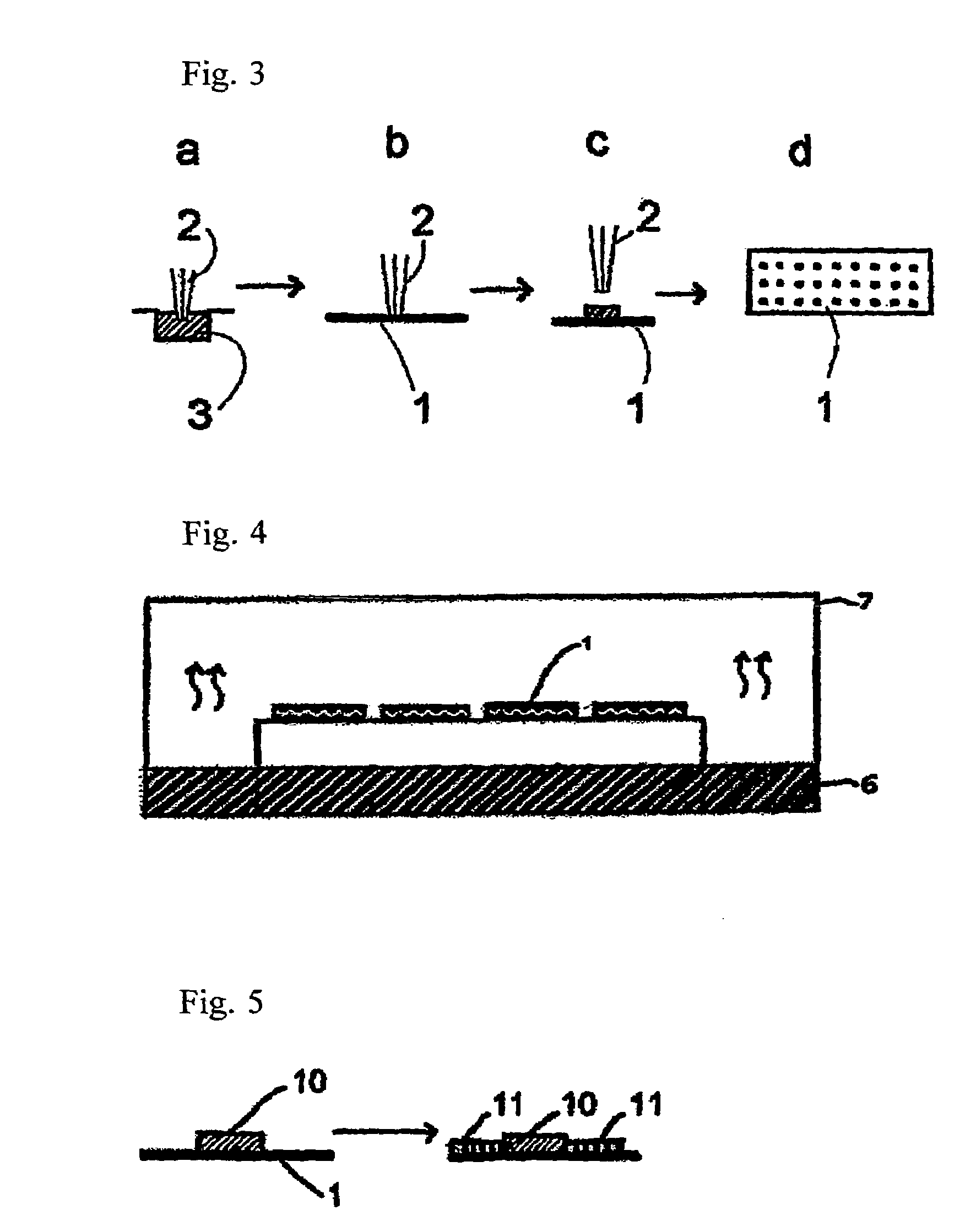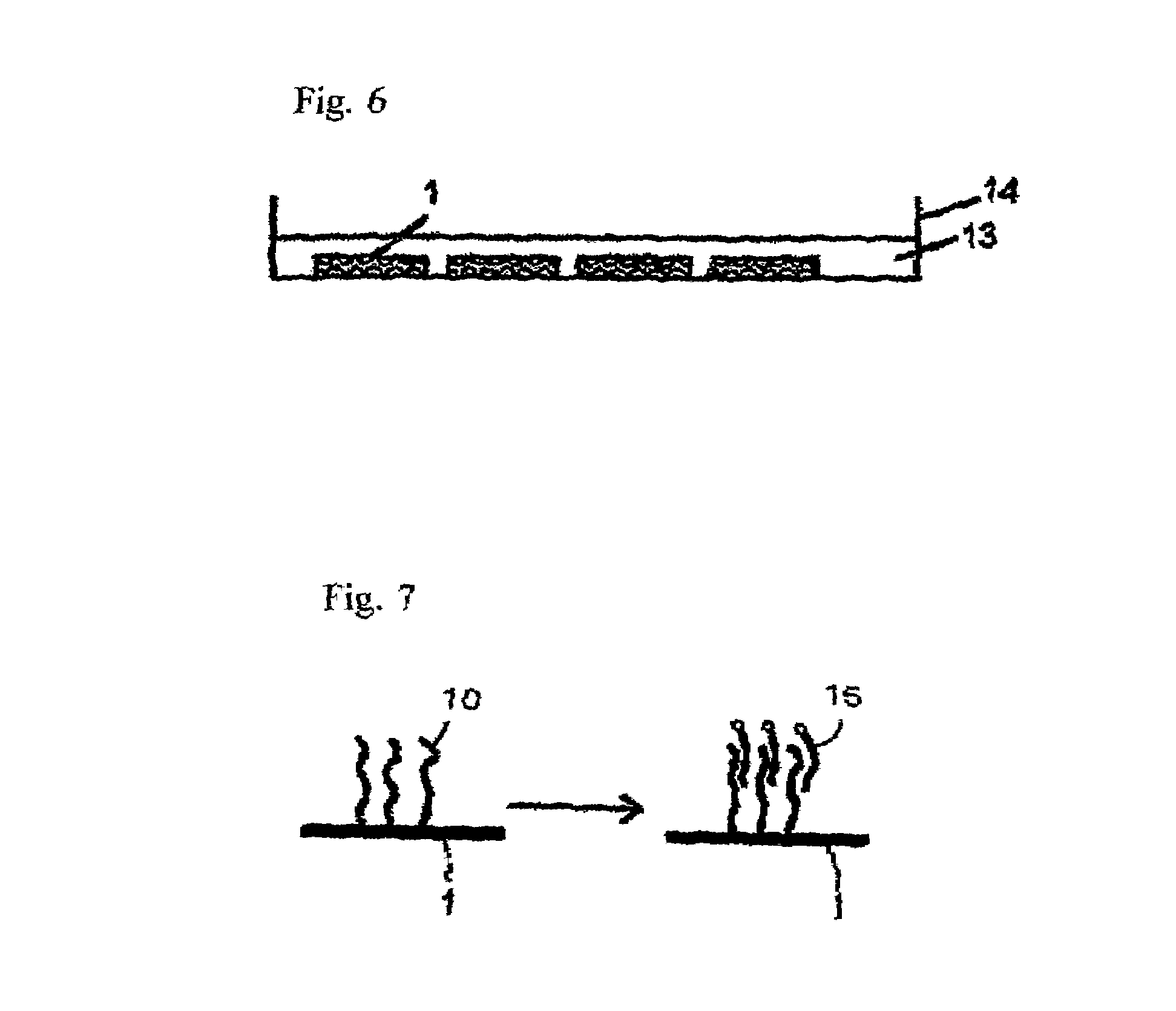Substrate activation kit and method for detecting DNA and the like using the same
a technology of activation kit and substrate, which is applied in the field of substrate activation kit, can solve the problems of difficult accurate detection of dna, high cost, and difficulty in chemical modification, and achieve the effect of accurate detection
- Summary
- Abstract
- Description
- Claims
- Application Information
AI Technical Summary
Benefits of technology
Problems solved by technology
Method used
Image
Examples
example 1
[0085]A protocol for using a soft diamond-coated glass slide is discussed below.
(1) Preparation of Soft Diamond-Coated Glass Slide
[0086]First, a glass slide was produced by forming a 25 nm-thick DLC film on the surface of a 25 mm-wide, 75 mm-long and 1 mm-thick glass by an ionization vapor deposition method using a gas mixture of 95% by volume of a methane gas and 5% by volume of a hydrogen gas.
[0087]Then, the surface of this glass slide was modified chemically.
[0088]Thus, the glass substrate surface was irradiated with a high pressure mercury lamp in an ammonia atmosphere for 10 minutes to effect an amination, and then the substrate was immersed in a solution of succinic anhydride in N-methylpyrrolidone for 60 minutes. As a result, a soft diamond-coated glass slide having a carboxyl group on the substrate surface was obtained.
[0089]The immobilization of a DNA on the soft diamond-coated glass slide was accomplished as shown in FIG. 1 after derivatizing the carboxy group on the surfa...
example 2
[0137]A soft diamond-coated glass slide similar to that employed in Example 1 was activated similarly to Example 1. The spotting was conducted using the solutions similar to those in Example 1 except for employing 10% glycerin instead of formamide.
(4) Incubation
[0138]For the incubation, a tight box containing a saturated aqueous solution of NaCl was placed in an incubator set at 4° C., and allowed to stand for about 1 hour for ensuring that the temperature of the entire tight box became 4° C. The tight box was taken out of the incubator, and the substrate was placed in while avoiding any contact with the saturated aqueous solution of NaCl (substrate being mounted on a raised part of the bottom), and then the box is returned to the incubator and allowed to stand for 1 hour. The tight box containing the saturated aqueous solution of NaCl was placed in an incubator set at 65° C., allowed to stand for 1 hour, and then dried. After drying, the washing was performed using a buffer solutio...
example 3
[0142]A soft diamond-coated glass slide similar to that employed in Example 1 was activated similarly to Example 1. The spotting was conducted using the solutions similar to those in Example 1 except for employing 10% glycerin instead of formamide.
(4) Incubation
[0143]For the incubation, a tight box containing a saturated aqueous solution of NaCl was placed in an incubator set at 4° C., and allowed to stand for about 1 hour for ensuring that the temperature of the entire tight box became 4° C. The tight box was taken out of the incubator, and the substrate was placed in while avoiding any contact with the saturated aqueous solution of NaCl (substrate being mounted on a raised part of the bottom), and then the box is returned to the incubator and allowed to stand for 1 hour. The tight box containing the saturated aqueous solution of NaCl was placed in an incubator set at 65° C., allowed to stand for 1 hour, and then dried. A 0.5% agarose gel was mounted on the substrate surface, and t...
PUM
| Property | Measurement | Unit |
|---|---|---|
| thickness | aaaaa | aaaaa |
| thickness | aaaaa | aaaaa |
| thickness | aaaaa | aaaaa |
Abstract
Description
Claims
Application Information
 Login to View More
Login to View More - R&D
- Intellectual Property
- Life Sciences
- Materials
- Tech Scout
- Unparalleled Data Quality
- Higher Quality Content
- 60% Fewer Hallucinations
Browse by: Latest US Patents, China's latest patents, Technical Efficacy Thesaurus, Application Domain, Technology Topic, Popular Technical Reports.
© 2025 PatSnap. All rights reserved.Legal|Privacy policy|Modern Slavery Act Transparency Statement|Sitemap|About US| Contact US: help@patsnap.com



